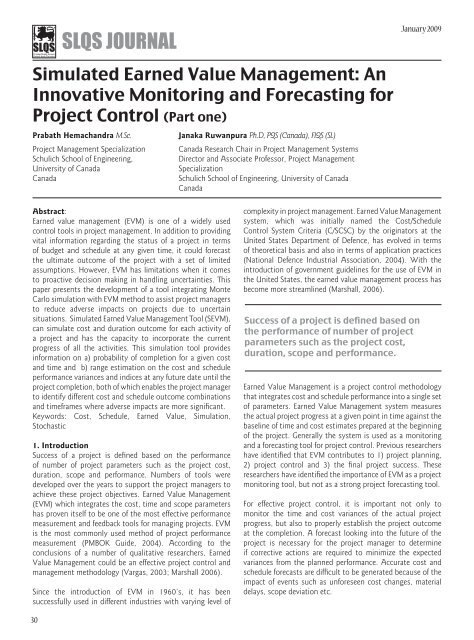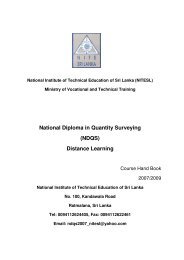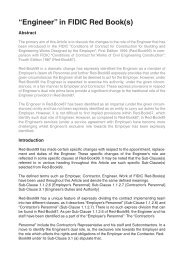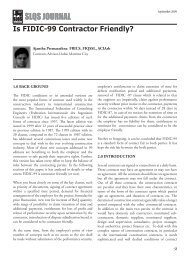SLQS-Journal Vol. 1 - Slqs-uae.org
SLQS-Journal Vol. 1 - Slqs-uae.org
SLQS-Journal Vol. 1 - Slqs-uae.org
Create successful ePaper yourself
Turn your PDF publications into a flip-book with our unique Google optimized e-Paper software.
<strong>SLQS</strong> JOURNALJanuary 2009Simulated Earned Value Management: AnInnovative Monitoring and Forecasting forProject Control (Part one)Prabath Hemachandra M.Sc.Project Management SpecializationSchulich School of Engineering,University of CanadaCanadaJanaka Ruwanpura Ph.D, PQS (Canada), FIQS (SL)Canada Research Chair in Project Management SystemsDirector and Associate Professor, Project ManagementSpecializationSchulich School of Engineering, University of CanadaCanadaAbstract:Earned value management (EVM) is one of a widely usedcontrol tools in project management. In addition to providingvital information regarding the status of a project in termsof budget and schedule at any given time, it could forecastthe ultimate outcome of the project with a set of limitedassumptions. However, EVM has limitations when it comesto proactive decision making in handling uncertainties. Thispaper presents the development of a tool integrating MonteCarlo simulation with EVM method to assist project managersto reduce adverse impacts on projects due to uncertainsituations. Simulated Earned Value Management Tool (SEVM),can simulate cost and duration outcome for each activity ofa project and has the capacity to incorporate the currentprogress of all the activities. This simulation tool providesinformation on a) probability of completion for a given costand time and b) range estimation on the cost and scheduleperformance variances and indices at any future date until theproject completion, both of which enables the project managerto identify different cost and schedule outcome combinationsand timeframes where adverse impacts are more significant.Keywords: Cost, Schedule, Earned Value, Simulation,Stochastic1. IntroductionSuccess of a project is defined based on the performanceof number of project parameters such as the project cost,duration, scope and performance. Numbers of tools weredeveloped over the years to support the project managers toachieve these project objectives. Earned Value Management(EVM) which integrates the cost, time and scope parametershas proven itself to be one of the most effective performancemeasurement and feedback tools for managing projects. EVMis the most commonly used method of project performancemeasurement (PMBOK Guide, 2004). According to theconclusions of a number of qualitative researchers, EarnedValue Management could be an effective project control andmanagement methodology (Vargas, 2003; Marshall 2006).Since the introduction of EVM in 1960’s, it has beensuccessfully used in different industries with varying level ofcomplexity in project management. Earned Value Managementsystem, which was initially named the Cost/ScheduleControl System Criteria (C/SCSC) by the originators at theUnited States Department of Defence, has evolved in termsof theoretical basis and also in terms of application practices(National Defence Industrial Association, 2004). With theintroduction of government guidelines for the use of EVM inthe United States, the earned value management process hasbecome more streamlined (Marshall, 2006).Success of a project is defined based onthe performance of number of projectparameters such as the project cost,duration, scope and performance.Earned Value Management is a project control methodologythat integrates cost and schedule performance into a single setof parameters. Earned Value Management system measuresthe actual project progress at a given point in time against thebaseline of time and cost estimates prepared at the beginningof the project. Generally the system is used as a monitoringand a forecasting tool for project control. Previous researchershave identified that EVM contributes to 1) project planning,2) project control and 3) the final project success. Theseresearchers have identified the importance of EVM as a projectmonitoring tool, but not as a strong project forecasting tool.For effective project control, it is important not only tomonitor the time and cost variances of the actual projectprogress, but also to properly establish the project outcomeat the completion. A forecast looking into the future of theproject is necessary for the project manager to determineif corrective actions are required to minimize the expectedvariances from the planned performance. Accurate cost andschedule forecasts are difficult to be generated because of theimpact of events such as unforeseen cost changes, materialdelays, scope deviation etc.30





